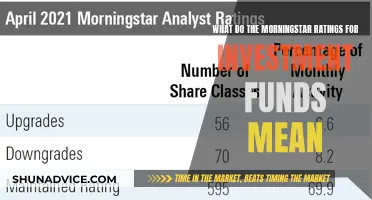
Investing in mutual funds is a popular option for those looking to diversify their portfolio and spread risk. The consensus is that a well-balanced portfolio with 20-30 stocks will diversify away the maximum amount of unsystematic risk. However, it is possible to over-diversify, which can prevent investors from making strong gains. So, how many mutual funds should you invest in?
What You'll Learn

Diversification and risk
Diversification is a key part of any investment strategy. By spreading your investments across a range of different assets, you can reduce the overall risk of your portfolio. This is because if one investment performs poorly, your other investments can help offset the losses.
When it comes to mutual funds, diversification can be achieved by investing in multiple funds that cover different markets, sectors, and asset classes. This way, even if one entire industry or sector performs poorly, your investments in other areas can remain safe.
However, it is important to note that it is possible to over-diversify your portfolio. If you invest in too many companies, and one of them performs exceptionally well, your overall investment may not benefit significantly. This is because the impact of that one company on your total investment will be very small.
Additionally, investing in too many mutual funds can lead to higher costs and mediocre performance. Each fund comes with its own set of fees and expenses, and having too many funds can cause these costs to add up quickly. This can eat into your returns and may not provide any additional benefit in terms of performance.
Therefore, it is important to carefully consider your investment goals and objectives when deciding how many mutual funds to invest in. While diversification is important, it is also crucial to avoid over-diversification and the potential costs and performance issues that come with it.
To avoid over-diversification, it is recommended to limit yourself to owning a few shares from most industries. When it comes to mutual funds, the number of funds you invest in will depend on your individual needs, goals, and risk tolerance. It is generally recommended to hold between 8 and 12 mutual funds to balance diversification and cost-efficiency.
By carefully selecting a diverse range of mutual funds and monitoring their performance, you can help ensure that your portfolio remains well-balanced and aligned with your investment goals.
JPMorgan Chase: Investing Your IRA in Mutual Funds
You may want to see also

Types of mutual funds
There are many types of mutual funds, and they can be classified in several ways. Here is a detailed overview of the different types of mutual funds:
- Growth funds primarily invest in stocks of companies with high growth potential. These funds are volatile and tend to rise sharply in bull markets and drop sharply in bear markets. They are suitable for investors with a high-risk tolerance and long-term investment horizons.
- Growth-and-income funds invest in stocks of companies that pay dividends and have good earnings growth prospects. They also invest in bonds to provide a more stable income. These funds are less risky than pure growth funds due to the diversification across stocks and bonds.
- Income funds focus on dividend-paying stocks and bonds, aiming to provide a steady income stream. They are less focused on growth and thus produce lower returns during market upswings but can soften the impact of a stock market downturn.
- Capital-preservation funds invest in short-term, low-risk securities such as US Treasury bills and CDs. While these funds aim to preserve the initial investment, they may not keep up with inflation.
Other Types of Mutual Funds
- Target-date funds are designed for retirement planning. They automatically adjust their asset allocation as the investor's retirement date approaches, shifting from growth funds to income-oriented funds over time.
- Portfolio series funds are a mix of mutual funds selected to help investors pursue diverse goals within a unified framework. They offer broad diversification and can be tailored to an investor's time frame, risk tolerance, and other factors.
- Asset allocation funds allocate specific amounts to fixed income and equities, depending on the fund's goals. They offer income and growth potential in a single fund.
- Index funds aim to replicate the performance of a specific stock market index, such as the S&P 500. They are passively managed, have lower fees, and often outperform actively managed funds.
- Actively managed funds aim to outperform a benchmark through tactical investment decisions made by fund managers. They have higher fees but offer the potential for higher returns.
- Money market funds invest in short-term, low-risk debt instruments, providing better returns than savings accounts while maintaining liquidity. However, they are not insured by the FDIC.
- Sector and theme funds focus on specific sectors of the economy, such as technology or healthcare, or broader themes like AI, which may cut across multiple sectors.
- Socially responsible or ethical funds invest only in companies and sectors that meet certain criteria, such as excluding tobacco, alcohol, or weapons manufacturers. Sustainable mutual funds focus on green technology and recycling.
Smart 401k Investing: Choosing the Right Funds for You
You may want to see also

How many funds are too many?
There is no consensus on the ideal number of mutual funds to own. The "right" number depends on your level of expertise, investment goals, and risk tolerance. Here are some guidelines to help you determine how many mutual funds are too many for your portfolio.
Firstly, it's important to understand the concept of diversification. Diversification is a risk mitigation strategy where you spread your investments across various assets or industries to reduce the impact of any single negative event. However, over-diversification can dilute your returns. For example, if you invest in too many companies, and one of them performs exceptionally well, your overall investment gains may be minimal since that company's impact on your total investment is limited.
When it comes to mutual funds, each fund already provides diversification by investing in multiple companies from diverse industries. Therefore, owning too many mutual funds may not significantly reduce your risk but may dilute your returns. Additionally, owning multiple funds can increase costs due to higher expense ratios, potentially impacting your overall performance.
To determine how many mutual funds are appropriate, consider the following:
- Your investment objectives and risk tolerance: If income is your primary goal, you may not need an international fund. If capital preservation is your objective, a small-cap fund may not be necessary.
- Overlap in fund holdings: Compare the underlying holdings of the funds you're considering. If there is significant overlap, you may be better off eliminating some funds to avoid paying fees for duplicate holdings.
- Expense ratios: When two funds have similar holdings, choose the less expensive option to maximize your returns.
- Impact on overall portfolio performance: If you're managing an existing portfolio, consider eliminating funds with small balances that may not significantly impact your overall returns.
As a general rule of thumb, unless you are an expert in mutual funds and the markets, consider the following guidelines:
- Large-cap mutual funds: Own up to 2 or 3 funds to avoid significant overlap in share ownership.
- Mid-cap mutual funds: Own up to 2 funds, as these carry higher risk but offer higher returns.
- Small-cap mutual funds: Own up to 2 funds due to their high risk and volatility.
- Debt funds: Own 1 or 2 funds, as these typically offer similar returns.
- Sectoral mutual funds: Own as many as the number of industries you have good knowledge about. Avoid investing in sectors you are unfamiliar with.
Overall, a well-diversified portfolio typically includes around 20 to 30 stocks, and a single mutual fund often contains five times that number of stocks. Therefore, owning a few carefully selected mutual funds can provide sufficient diversification for most investors. Remember, the key is to strike a balance between diversification and maximizing returns while managing costs and risk.
Emerging Market Funds: Where to Invest and How
You may want to see also

Building your own portfolio
The consensus is that a well-balanced portfolio should include approximately 20 to 30 stocks to diversify away the maximum amount of unsystematic risk. However, a single mutual fund often contains five times that number of stocks, so you need to be careful not to over-diversify.
If you prefer to build your own portfolio rather than buy a pre-made one, you can take some simple steps to limit the number of funds while still feeling comfortable with your holdings. First, consider your objectives. If income is your primary goal, an international fund may not be necessary. If you're looking to preserve capital, a small-cap fund may not be needed.
Once you've decided on the mix of funds you want, compare their underlying holdings. If multiple funds have significant overlap in holdings, some can be eliminated as there is no point in having multiple funds that hold the same underlying stocks.
Next, look at the expense ratios. When two funds have similar holdings, go with the less expensive choice and eliminate the other. Every penny saved on fees is a penny that can work for you. If you're working with an existing portfolio, get rid of funds with balances that are too small to impact overall performance. If you have three large-cap funds, for example, move the money to a single fund. This will likely decrease the amount spent on management-related expenses while keeping your level of diversification the same.
Remember, there is no magical "right" number of mutual funds for your portfolio. The number of funds you invest in should depend on your risk profile and how well you know the market.
Retirement Fund: Investing for a Secure Future
You may want to see also

Reviewing and rebalancing
Regular Reviews
Periodic reviews of your mutual fund investments are essential. It is recommended to review your investments at least once a year. This allows you to assess the performance of your funds and make any necessary adjustments. During your review, evaluate the returns generated by each fund and compare them to similar funds in the market. Look for any consistent underperformance and take corrective actions if needed.
Rebalancing Across Asset Classes
Diversification is a vital strategy, and it should be applied not only across different asset classes but also within the same asset class. This is particularly important when investing in equities. Ensure you have a mix of large-cap, mid-cap, and small-cap funds, adjusting the proportions based on your risk tolerance. For example, a common rule of thumb suggests allocating 40% to large-cap, 30% to mid-cap, and 30% to small-cap funds within your equity allocation.
Overdiversification
While diversification is important, overdiversification can dilute your returns. Avoid investing in too many mutual funds, as this can reduce the impact of strong-performing funds on your overall portfolio. Instead, focus on a well-chosen selection of funds that align with your investment goals.
Expense Ratios
When reviewing your funds, pay close attention to expense ratios. These fees can add up, impacting your overall returns. If you find similar funds with lower expense ratios, consider switching to them to maximise your investment gains.
Lifecycle Funds
If you prefer a more hands-off approach, consider lifecycle or target-date funds. These funds invest in multiple underlying funds and are designed to be held until retirement age. They offer a simple, long-term solution without the need for frequent rebalancing.
Customisation
Remember that the ideal number of mutual funds and the specific funds you choose will depend on your unique circumstances, including your financial goals, risk tolerance, and time horizon. Customise your portfolio to fit your needs, seeking professional advice if necessary.
By regularly reviewing and rebalancing your mutual fund investments, you can ensure that your portfolio remains aligned with your investment strategy and that you are on track to achieve your financial objectives.
Tracking Hedge Fund Investments: Strategies for Success
You may want to see also
Frequently asked questions
There is no one-size-fits-all answer, but diversification is key. While investing in multiple mutual funds can help spread risk, over-diversification can hinder gains. A well-balanced portfolio typically holds 20-30 stocks, but a single mutual fund can contain up to 100 stocks. Therefore, investing in one broad index fund may be sufficient.
While diversification is important, too much of it can be detrimental. Adding too many funds can dilute their individual impact on performance, leading to mediocre returns. Additionally, the expense ratios of multiple funds can accumulate and outweigh the benefits.
Investing in multiple mutual funds allows you to spread risk across different industries and sectors. This means that even if one industry or sector is performing poorly, your investment in other areas can help safeguard your overall portfolio.
The number of mutual funds to invest in depends on your personal circumstances and risk tolerance. Generally, a good rule of thumb is to hold 8 funds, with a range of +/- 2. However, this can vary depending on your expertise and preferences.
There are various types of mutual funds, including Large Cap, Mid Cap, Small Cap, and Debt Funds. Large Cap funds invest in well-established companies and are generally lower risk. Mid Cap and Small Cap funds offer higher growth potential but come with higher risk. Debt funds are low-risk, low-return options that provide consistent returns. The mix of funds you choose should align with your investment goals and risk appetite.







